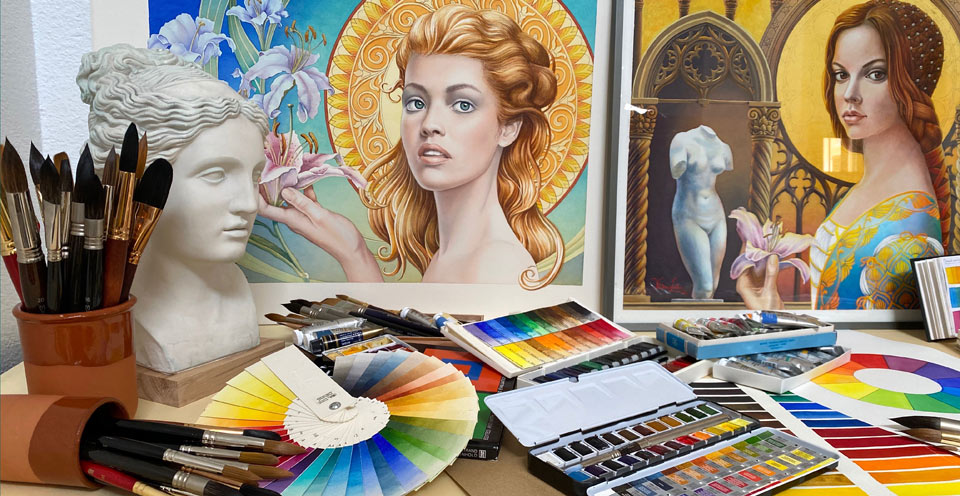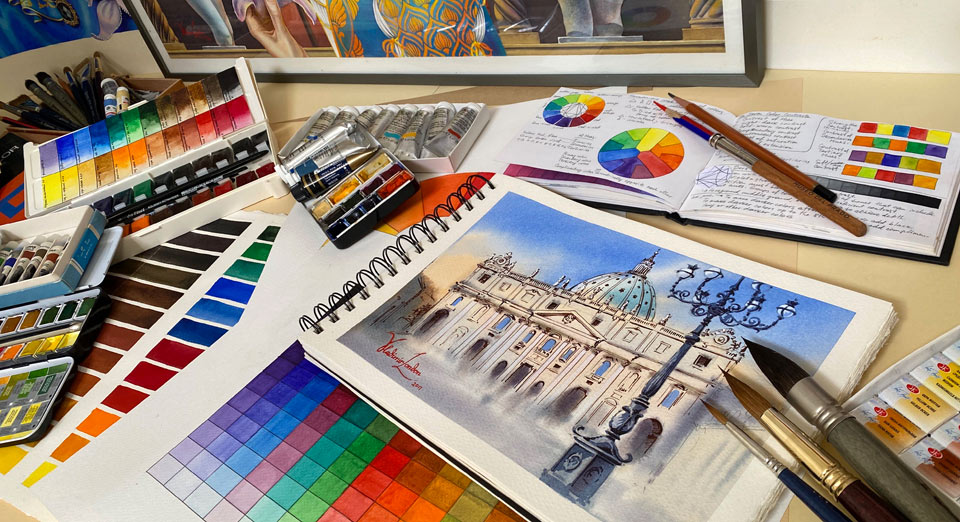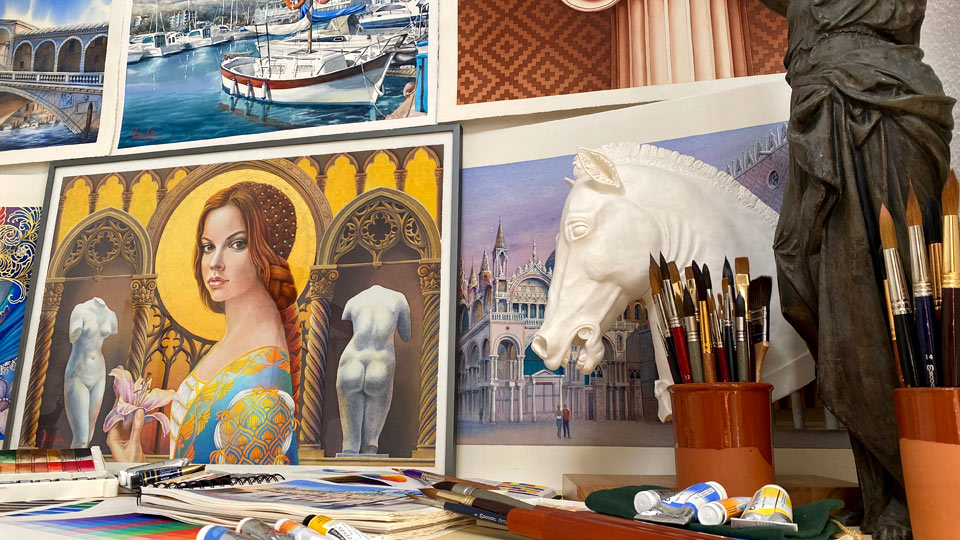A self-study, self-paced course where you can learn how to paint in watercolor by watching video lessons and doing assignments
$297 USD
ENROLL NOWA self-study, self-paced course where you can learn how to paint in watercolor by watching video lessons and doing assignments
$297 USD
ENROLL NOWOne-to-one, unlimited and custom-tailored to your skills and needs Personal Tutoring by the Watercolor Academy teachers
$997 USD
ENROLL NOWVideo lesson by Vladimir London
In this video lesson, you will discover what watercolor is and its place in the history of art.
The term "watercolor" was first used by Italian painter Cennino Cennini in his book "Il Libro dell'Arte" (The Craftsman's Handbook). This doesn't mean that the watercolor technique originates in the fifteenth century.

Watercolor as a medium was used centuries before the early Renaissance period. I will briefly outline its place in the history of arts in the next chapter.
So, what is and what is not watercolor?
"Watercolor" has several meanings—it can be a painting medium, a picture painted in that medium, and the art of painting such pictures.
Watercolor paint is made of a pigment or dye mixed with a water-soluble binder (most often, gum arabic). Other ingredients, like glycerin, are added to make the paint semi-soft, elastic, and mold-resistant. It is thinned with water to achieve the classic transparent look.
This medium has one very distinct characteristic—paler colors are created by diluting paints rather than adding white pigments.
This where the name "watercolor" comes from.
By this definition, other water-thinned mediums like gouache or tempera, for example, are not watercolors because white is added to lighten them.
In watercolor artworks, white areas are made by leaving bits of the support unpainted, and light areas are created by using naturally transparent paints.
These days, the most common support for watercolor is a white paper.

Many books, essays, and articles have been written on the art history. Because this video course is a practical guide, I will only describe it briefly.
The origin of watercolor is uncertain. Perhaps watercolor is as old as art itself, dating back to the Stone Age when a prehistoric man mixed earth and charcoal with water and painted the very first wet-on-dry artwork on a cave wall.
Fast-forward 30...40 thousand years, ancient Egyptians used water-mixable transparent paints to illustrate papyrus scrolls. The earth pigments, such as the ochres and siennas, and minerals, such as reds cinnabar, blue azure, and green malachite were mixed with gum arabic and egg white. These water-based paints were technically watercolors. Many of these artworks have survived because they were found in dry, concealed spaces.
With the invention of paper in China about 2,000 years ago, the watercolor medium takes another path. The color of the paper played an integral role in art. Chinese and Japanese masters also painted in watercolor on silk. Their art often featured calligraphy, as well as contemplative landscape views, animals, and depictions of everyday life.
During the European Middle Ages, watercolor was used by monks to illustrate hand-written books and manuscripts. The canvas was usually either parchment or vellum. Hand-painted books were intricately illustrated with biblical scenes, stories from saints' lives, and historical events.
Eventually, the secrets of paper manufacturing spread from China to the Middle East, where Arabs improved the technology. From there, papermaking reached Europe.
Fifteen hundred years after the invention of paper, Europe celebrated great advances in drawing, painting, and sculpture during the Renaissance period. By this time, paper was widely available to artists.
Contemporary European watercolor has roots in the Northern Renaissance. German artist Albrecht Durer (1471 - 1528) was one of the first to recognize the potential of this medium. He created breathtaking landscapes, wildlife, topographical, and botanical pieces.
During the Baroque era, watercolor was the medium of choice for illustrating nature books, albums, scientific publications, maps, and architectural plans. Watercolor was also very popular for miniature portraiture on paper, velum, and ivory.
Flemish artist Anthony Van Dyck (1599 - 1641) further advanced watercolor techniques by introducing translucent washes. It was an important innovation, that allowed artists to let the color of the paper shine through pigments and play a role in the artwork.
Masters like Claude Lorrain (1600 or 1604/5 - 1682), Giovanni Benedetto Castiglione (1609 - 1664), and many other baroque Dutch and Flemish artists used watercolors.
Watercolor spread across Europe; by the end of the 18th century, it was widely popular in Russia. Watercolor was not just a craft for artists, but also a part of aristocratic education and a must-have skill for architects, engineers, and military officers.
The English watercolor artists of that time often traveled together with researchers on geological and archaeological expeditions, depicting new worlds and discoveries. Middle-class housewives practiced watercolor along with their sewing. Watercolor became a national art.
During the Golden Age of watercolor in England, watercolor became an independent and established medium in art. Paul Sandby (1730–1809), the father of English watercolor, Thomas Girtin (1775–1802), landscape painter, and Joseph Mallord William Turner (1775–1851) further refined the watercolor techniques. Many other British artists left their mark in English watercolor—Thomas Gainsborough (1727-1788), William Pars (1742-1782), John Sell Cotman (1782-1842), and Samuel Prout (1783–1852), just to name a few.
By the 19th century, watercolor became so popular that several art societies were established—the Society of Painters in Water Colours (1804, now the Royal Watercolour Society), the New Water Colour Society (1832, now the Royal Institute of Painters in Water Colours), and the Scottish Society of Painters in Water Colour (1878, now the Royal Scottish Society of Painters in Watercolour).
The Watercolour Society of Ireland (WCSI) was founded in 1870 and in Northern Ireland, the Ulster Watercolour Society (UWS) was created.

The Russian Watercolor Society was founded in St. Petersburg in 1880. Many Russian artists of the 19th century used watercolor in their work.
Watercolor was an important medium for European artists, including Eugène Delacroix (1798-1863), François Marius Granet (1775-1849), Adolph Menzel (1815-1905), Stanisław Masłowski (1853-1926), and many other distinguished painters and draftsmen.
Watercolor found its way to the American continent first through European artists, who documented the "new world." The American Society of Painters in Watercolor (now the American Watercolor Society) was founded in 1866. By the end of the 19th century, artists Thomas Moran (1837-1926), Thomas Eakins (1844-1916), John Singer Sargent (1856-1925), James A. M. Whistler (1834-1903), and many others had established American watercolor painting.
At the beginning of the 20th century in Europe, Paul Signac (1863-1935) and Paul Cézanne (1839-1906) developed impressionism. The 20th century has seen such watercolorists as the Russian abstract painter Wassily Kandinsky (1866-1944), the Swiss modernist Paul Klee (1879-1940), and the French expressionist painter Raoul Dufy (1877-1953).
In the USA, impressionism, and post-impressionism European styles were often imitated. At the same time, many regional schools came to life. The Cleveland Museum of Art was a central point for artists. The California Watercolor Society was founded in 1921 (now the National Watercolor Society).
After the 1950s, watercolor art in the U.S. suffered some decline, giving way to abstract expressionism, amateur painters, and advertising. Nevertheless, artists like Andrew Wyeth (1917-2009), Philip Pearlstein (born 1924), Joseph Raffael (born 1933), and many others continued working in this medium.
Unlike in America and Western Europe, strong art school traditions in Russia kept watercolor culture alive and many contemporary artists continue to push the boundaries of the medium. Here are just a few of my favorite artists...
A self-study, self-paced course where you can learn how to paint in watercolor by watching video lessons and doing assignments
One-time payment - Lifetime membership
$297 USD
One-to-one, unlimited and custom-tailored to your skills and needs Personal Tutoring by the Watercolor Academy teachers
One-time payment - Lifetime membership
$997 USD